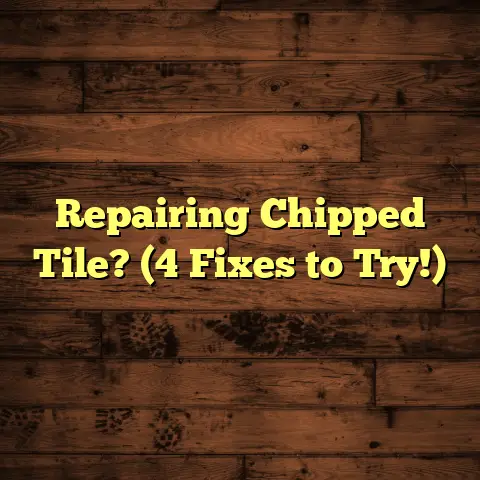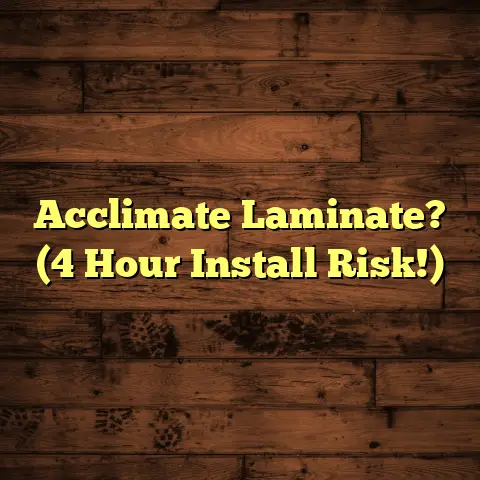How To Fix Uneven Garage Floor (DIY in 4 Hrs!)
I’m Mike, a flooring contractor with over 15 years under my belt.
And let me tell you, I’ve seen my fair share of garage floors that look like they belong on a rollercoaster.
But don’t worry!
An uneven garage floor is a common problem, and it’s one you can absolutely tackle yourself.
What I want to cover is how technology has revolutionized home improvement, especially flooring.
We’re talking about game-changing materials and tools that make DIY projects like this way easier than they used to be.
Think about it: self-leveling compounds that practically pour themselves, laser levels that give you pinpoint accuracy, and concrete repair kits that are stronger and more user-friendly than ever before.
A level garage floor isn’t just about looks; it’s about functionality and safety.
Imagine your car rolling slightly every time you park, or water pooling in one spot.
Not ideal, right?
Let’s dive in and get that garage floor smooth and functional in just about 4 hours!
Section 1: Understanding the Problem
1.1 Identifying Uneven Floors
So, what exactly is an uneven garage floor?
Well, it’s any surface that deviates from a perfectly horizontal plane.
Think dips, humps, or slopes that can cause problems.
Common Culprits:
- Settling: Over time, the soil beneath your garage can shift, causing the concrete slab to settle unevenly.
- Moisture Issues: Water can seep under the slab, eroding the soil or causing the concrete to expand and contract.
- Poor Initial Construction: Sometimes, the original concrete pour just wasn’t done right, leading to unevenness from the start.
How to Assess the Damage:
- The Level Test: Grab a good ol’ level (a 4-foot one works best) and place it on the floor in various spots.
If the bubble isn’t centered, you’ve got an uneven area. The Marble Test: Place a marble on the floor.
If it rolls on its own, you’ve got a slope.I once worked on a garage where the marble rolled right out the door!
That was an extreme case, but it showed just how bad things can get.
1.2 Importance of Fixing Uneven Floors
Why bother fixing an uneven garage floor in the first place?
Functional Reasons:
- Drainage Issues: Uneven floors can cause water to pool in certain areas, leading to mold, mildew, and potential damage to your belongings.
- Safety Hazards: Tripping hazards are a real concern, especially if you have kids or elderly family members.
- Vehicle Maintenance: Trying to work on your car on an uneven surface is a nightmare.
It can be unstable and unsafe.
Aesthetic Reasons:
- Appearance: Let’s face it, an uneven floor just looks bad.
It can detract from the overall appearance of your garage and your home. -
Resale Value: If you’re planning to sell your home, a level garage floor can increase its value and appeal to potential buyers.
I remember a client who was trying to sell his house.
The garage floor was so uneven that potential buyers kept pointing it out.
Once we leveled it, the house sold within a week!
Section 2: Tools and Materials Needed
Alright, let’s get down to the nitty-gritty.
Here’s what you’ll need to tackle this project like a pro.
2.1 Essential Tools
- Leveling Tool:
- Laser Level: This is the Cadillac of leveling tools.
It projects a laser beam across the room, giving you a precise reference line. - Traditional Level: A good old-fashioned level will also do the trick.
Just make sure it’s at least 4 feet long for accurate readings.
- Laser Level: This is the Cadillac of leveling tools.
- Trowel: For spreading and smoothing the self-leveling compound. A concrete finishing trowel is ideal.
- Broom and Dustpan: Essential for cleaning the floor before you start.
- Mixing Bucket: A large, sturdy bucket for mixing the self-leveling compound.
- Drill with Mixing Paddle: This will save you a ton of time and effort when mixing the compound.
- Spiked Roller: This helps release air bubbles from the self-leveling compound for a smoother finish.
- Safety Gear:
- Gloves: To protect your hands from the chemicals in the compound.
- Goggles: To keep dust and debris out of your eyes.
- Mask: To avoid inhaling dust and fumes.
2.2 Materials
Self-Leveling Compound: This is the star of the show.
It’s a cement-based mixture that flows easily and hardens into a smooth, level surface.Pro Tip: Choose a compound specifically designed for garage floors.
These are typically more durable and resistant to chemicals and wear.
* Concrete Patching Material: For filling any large cracks or holes before applying the self-leveling compound.
* Primer (if necessary): Some self-leveling compounds require a primer to ensure proper adhesion to the existing concrete.
Check the manufacturer’s instructions.
* Water: For mixing the self-leveling compound and concrete patching material.
* Optional Additives: * Acrylic Fortifier: Adds strength and flexibility to the self-leveling compound.
* Fiber Reinforcement: Helps prevent cracking in large areas.
Section 3: Preparation Steps
Preparation is key to any successful DIY project.
Trust me, skipping these steps will only lead to headaches later on.
3.1 Clearing the Garage
Before you can even think about leveling the floor, you need to empty the garage completely.
This means moving everything out: cars, tools, storage bins, bikes, you name it.
Tips for Efficient Clearing:
- Organize: As you remove items, group them together by category (e.g., tools, sports equipment, holiday decorations).
- Label: Label boxes clearly so you know what’s inside when it’s time to put everything back.
-
Temporary Storage: If possible, move your belongings to a storage unit or another part of your house.
If you don’t have space, consider renting a portable storage container that you can keep in your driveway.
3.2 Cleaning the Floor
Once the garage is empty, it’s time to clean the floor thoroughly.
This will ensure that the self-leveling compound adheres properly.
Cleaning Steps:
- Sweep: Use a broom to remove any loose dirt, dust, and debris.
- Scrub: Use a concrete cleaner and a scrub brush to remove oil stains, grease, and other stubborn grime.
- Rinse: Rinse the floor thoroughly with water and let it dry completely.
Cleaning Products:
- Concrete Cleaner: Look for a cleaner specifically designed for concrete floors.
- Degreaser: For removing tough oil and grease stains.
-
TSP (Trisodium Phosphate): A powerful cleaner that can remove almost anything.
Warning: TSP can be harsh, so wear gloves and eye protection when using it.
3.3 Assessing and Marking the Area
Now that the floor is clean, it’s time to assess the extent of the unevenness and mark the areas that need leveling.
Assessment:
- Use a Level: Place a level on the floor in various spots and note the areas that are uneven.
- Identify Low Spots: Look for areas where water tends to pool.
These are usually the lowest spots on the floor. - Measure Height Differences: Use a measuring tape to determine the height difference between the highest and lowest points on the floor.
This will help you determine how much self-leveling compound you need.
Marking:
- Use a Marker: Use a permanent marker to outline the areas that need leveling.
- Create a Dam: For areas that are significantly lower than the surrounding floor, you may need to create a dam using foam or wood strips to prevent the self-leveling compound from flowing into unwanted areas.
Section 4: The DIY Process
Okay, folks, this is where the magic happens!
Let’s get that floor leveled!
4.1 Mixing the Self-Leveling Compound
Mixing the self-leveling compound is crucial.
Get it wrong, and you’ll end up with a lumpy, uneven mess.
Step-by-Step Guide:
- Read the Instructions: Carefully read the manufacturer’s instructions on the bag of self-leveling compound.
- Add Water: Pour the recommended amount of water into a clean mixing bucket.
- Add Compound: Gradually add the self-leveling compound to the water while mixing with a drill and mixing paddle.
- Mix Thoroughly: Mix for at least 3-5 minutes, until the compound is smooth and lump-free.
- Check Consistency: The compound should have the consistency of pancake batter.
If it’s too thick, add a little more water.
If it’s too thin, add a little more compound.
Common Pitfalls:
- Adding Too Much Water: This will weaken the compound and make it more prone to cracking.
- Not Mixing Thoroughly: This will result in lumps and an uneven surface.
- Using the Wrong Mixing Paddle: A paddle designed for mixing concrete is essential for achieving a smooth, consistent mix.
4.2 Applying the Compound
Now that you have a perfectly mixed batch of self-leveling compound, it’s time to apply it to the floor.
Application Steps:
- Pour: Pour the compound onto the floor, starting at the lowest point.
- Spread: Use a trowel to spread the compound evenly over the uneven areas.
- Work Quickly: Self-leveling compound sets quickly, so you need to work fast.
- Use a Spiked Roller: After pouring and spreading the compound, use a spiked roller to release any trapped air bubbles.
Tips for Efficient Application:
- Work in Sections: If you have a large area to cover, work in sections to prevent the compound from setting before you can spread it evenly.
- Use a Helper: If possible, enlist the help of a friend or family member to mix and pour the compound while you spread it.
- Don’t Overwork It: Once you’ve spread the compound evenly, don’t keep messing with it.
Let it self-level.
4.3 Finishing Touches
Once the self-leveling compound has been applied, there are a few finishing touches you can add to ensure a smooth, durable surface.
Finishing Steps:
- Smooth the Surface: Use a trowel to smooth out any imperfections in the surface.
- Check for Imperfections: After the compound has partially set, check for any remaining imperfections and smooth them out with a trowel.
- Apply a Sealer (Optional): Once the compound has fully cured, you can apply a concrete sealer to protect it from stains and wear.
Section 5: Curing and Final Steps
Patience is a virtue, especially when it comes to letting the self-leveling compound cure properly.
5.1 Curing Time
The curing time for self-leveling compound can vary depending on the product and the environmental conditions.
General Guidelines:
- Avoid Walking on the Floor: For at least 24 hours after application.
- Avoid Driving on the Floor: For at least 72 hours after application.
- Full Cure: Most self-leveling compounds take 7-14 days to fully cure.
Factors Affecting Curing Time:
- Temperature: Warmer temperatures will speed up the curing process.
- Humidity: High humidity can slow down the curing process.
- Thickness of the Compound: Thicker layers of compound will take longer to cure.
5.2 Final Inspection
Once the self-leveling compound has fully cured, it’s time to inspect the finished floor.
Inspection Checklist:
- Levelness: Use a level to check that the floor is now level.
- Smoothness: Run your hand over the surface to check for any bumps or imperfections.
- Cracks: Look for any cracks in the surface.
- Bonding: Make sure the self-leveling compound is properly bonded to the existing concrete.
Section 6: Maintenance Tips
Now that you have a beautifully leveled garage floor, you want to keep it that way.
6.1 Regular Care
Cleaning:
- Sweep Regularly: Sweep the floor regularly to remove dirt and debris.
- Mop with a Mild Detergent: Mop the floor with a mild detergent and water as needed.
- Avoid Harsh Chemicals: Avoid using harsh chemicals or abrasive cleaners, as these can damage the surface.
Protection:
- Use Floor Mats: Place floor mats under your car and in high-traffic areas to protect the floor from stains and wear.
- Clean Up Spills Immediately: Clean up any spills immediately to prevent staining.
6.2 Addressing Future Issues
Even with proper maintenance, you may encounter issues down the road.
Potential Problems:
- Cracking: Cracks can develop over time due to settling or temperature changes.
- Delamination: The self-leveling compound may start to peel away from the existing concrete.
- Unevenness: The floor may become uneven again due to settling or other factors.
When to Call a Professional:
- Large Cracks: If you notice large cracks (more than 1/4 inch wide), it’s best to call a professional.
- Extensive Delamination: If a large area of the self-leveling compound is peeling away, it’s time to call in the experts.
- Recurring Unevenness: If the floor becomes uneven again after you’ve already leveled it, there may be an underlying problem that requires professional attention.
Conclusion
So, there you have it!
Fixing an uneven garage floor is a project you can absolutely tackle yourself.
With the right tools, materials, and a little bit of elbow grease, you can transform your garage into a functional and aesthetically pleasing space.
Not only will you save money by doing it yourself, but you’ll also gain a sense of accomplishment and pride in your DIY skills.
Remember, a level garage floor isn’t just about looks; it’s about safety, functionality, and adding value to your home.
So, roll up your sleeves, gather your supplies, and get ready to level that garage floor!
You got this!





